Quick Summary: This article explores why European companies, from Germany to the Netherlands and the UK, prefer remote Indian teams for React development. We’ll dive into the talent shortages driving this trend, the benefits (from cost savings to around-the-clock productivity), real-world insights, and how to make such partnerships successful. By the end, you’ll understand not only why this approach is booming, but also how to leverage it for your own projects.
Imagine a fast-growing startup in Berlin or Amsterdam struggling to hire an experienced React developer. Months pass, local candidates are scarce or demand sky-high salaries, and critical product deadlines loom.
Why European Companies Prefer Remote Indian React Teams
This scenario is increasingly common across Europe. To solve it, many tech founders and CTOs are looking beyond their borders – often to India – and discovering a game-changing strategy: building remote React development teams in India.
Europe’s Tech Talent Shortage and React Demand
Europe’s digital economy is booming – but finding the tech talent to fuel that boom is an increasing challenge. The continent is facing a well-documented shortage of skilled software developers. Recent estimates suggest the EU has a shortfall of around 500,000 developers.
In major hubs like Germany, the UK, and the Netherlands, demand for software expertise far outstrips supply. For example, tech jobs accounted for 14% of all job openings in the UK in 2022, with around 870,000 tech vacancies posted between January and May 2022 alone – the highest in years. This talent crunch is especially pronounced in high-demand specialties like web development.
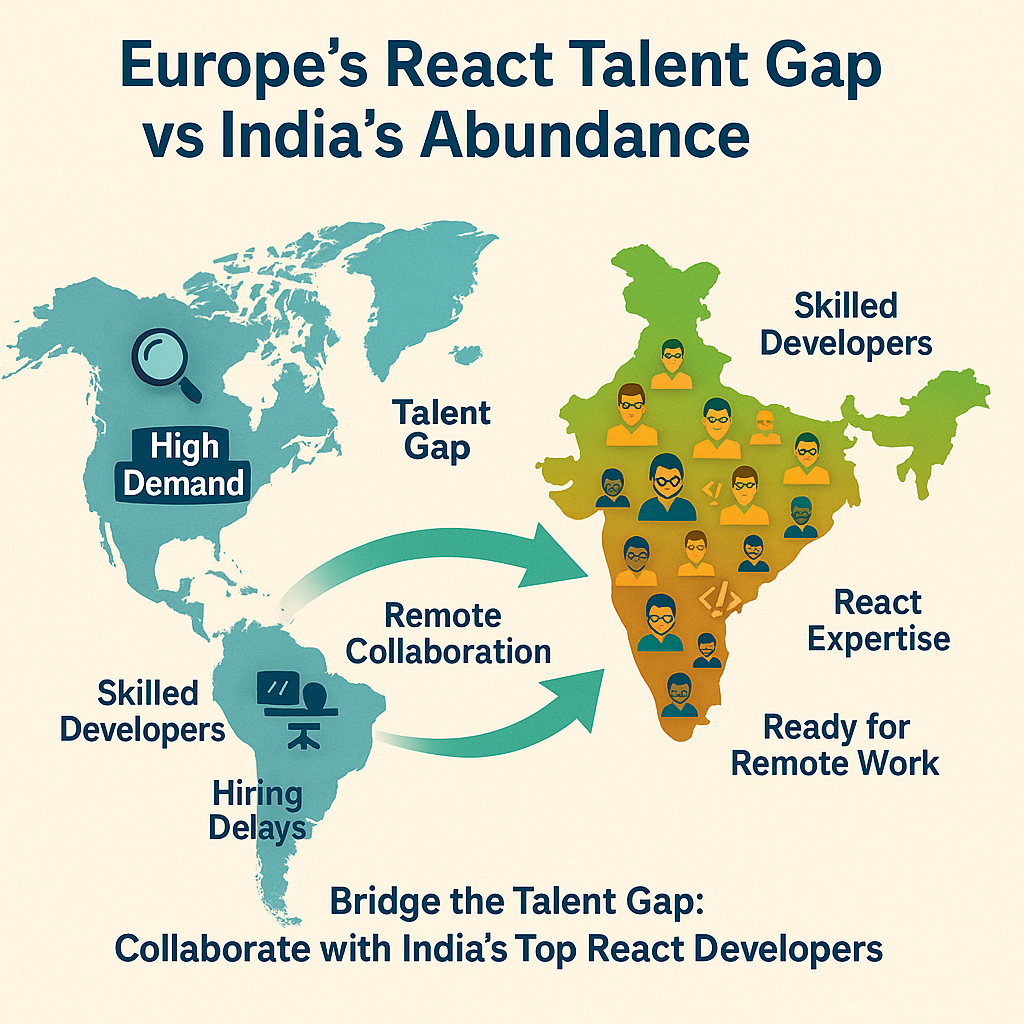
React.js, being one of the world’s most popular front-end frameworks, epitomizes this demand. Companies need React developers to build modern, dynamic web applications and user interfaces. However, finding experienced React talent locally has become like finding a unicorn.
In a recent developer survey, React was identified as one of the top two web technologies used by programmers worldwide, which means everyone is competing for the same skilled individuals. European startups and enterprises alike are competing not only with each other, but with US tech giants and other global players for these React experts.
This intense competition drives up salaries and lengthens hiring times. One report noted that 67% of EU companies struggle to find developers and often end up paying ~30% higher salaries and taking 3× longer to hire locally (as cited by industry experts). The result? Critical React roles stay unfilled for months, delaying product roadmaps and growth.
Remote Work and the New Normal
The good news is that a tectonic shift in work culture has opened new possibilities. The COVID-19 pandemic dramatically accelerated the acceptance of remote work. Practically overnight, companies learned to collaborate with team members via Slack, Zoom, and GitHub from wherever they were located.
This shift proved that productivity can thrive without a physical office – and it lowered many previous barriers about working with teams across borders. In Europe especially, where many companies were traditionally hesitant about offsite workers, there is now a “remote-friendly” mindset.
This new normal directly benefits companies considering overseas development teams. Geography is no longer a limiter for hiring. A React developer in India can contribute just as effectively as one sitting in London or Munich, as long as the team has the right tools and processes.
In fact, familiarity with remote collaboration has made European firms far more comfortable with offshoring than they were a decade ago. Leaders have realized that if their in-house staff are working from home (possibly scattered across their own country), they might as well tap the global talent pool.
The playing field has been leveled – what matters now is getting the best people, not where they are. This paradigm shift set the stage for the rise of remote Indian teams as a strategic solution to Europe’s talent shortage.
Benefits of Hiring Remote Indian React Teams
When European companies form remote teams in India, they unlock benefits in multiple dimensions: cost, talent availability, speed, quality, communication, and more.
Let’s break down the key advantages one by one.
-
Cost Efficiency
-
Access to a Large Talent Pool
-
Faster Hiring and Scalability
-
Quality and Expertise
-
English Proficiency and Communication
-
Time Zone Advantage
-
Cultural Compatibility and Work Ethic
Why India, specifically, for React development talent? Simply put, India offers a combination of advantages that few other regions can match. Over the past few decades, India has positioned itself as the “Silicon Valley of Asia” – a powerhouse of IT expertise and outsourcing know-how.
Read: Tips to Hire Remote Developers
1. Cost Efficiency
For any business, especially startups, cost is a huge factor. Hiring developers in Western Europe is expensive. Salaries, benefits, and taxes add up quickly. Remote Indian teams provide immediate relief on this front. The salary expectations for React developers in India are dramatically lower than those in Europe, due to differences in cost of living.
The average annual salary for a React.js developer is about $80k in the UK and ~$66k in the Netherlands, whereas in India it’s around $12k on average. Hourly rate comparisons show a similar gap – roughly $30–40/hour in Western Europe vs. $7–8/hour in India.

In other words, European companies can save 50–80% on development labor costs by utilizing Indian teams, even after accounting for outsourcing vendor margins or additional coordination costs.
These savings aren’t trivial – they can make the difference between a project being financially viable or not. For startups operating on limited runway, accessing high-quality React talent at a fraction of local cost allows them to stretch their budgets and invest more in product development or marketing. Even large enterprises find that offshoring development can significantly reduce their IT expenditures.
According to Kearney’s Global Services Location Index, many developing countries (like India) are over three times more financially attractive than higher-cost countries. India consistently ranks at or near the top of global outsourcing destination lists for its cost-to-value balance.
Importantly, cost efficiency doesn’t mean cutting corners on quality (as we’ll discuss later). Think of it this way: hiring an Indian React team is not about “cheap labor,” but about “smart arbitrage.” You’re accessing skilled professionals who command lower wages in their economy, thus creating value for both sides.
Many European firms reinvest the cost savings into additional features or team members, accelerating their development cycles. As The Scalers (an offshoring partner) reported, roles that might take months to fill in Western Europe can be filled in weeks in India, and these hires often stay with the company longer, reducing turnover costs. The financial upside is compelling.
2. Access to a Large Talent Pool
Beyond cost, the depth of India’s talent pool is a massive draw. India is the second-largest English-speaking population in the world and produces a staggering number of STEM graduates. In fact, India churns out over a million engineering and tech graduates every year. Many of these graduates specialize in computer science and software engineering.
The country’s developer base is expanding so rapidly that GitHub projects India will have the world’s largest developer community by 2028, surpassing the U.S.. For web development and React in particular, India’s focus on IT education means tens of thousands of new React-capable developers enter the workforce each year.
This abundance matters greatly to European firms facing local scarcities. Instead of a shallow pool where every mid-level React developer has 5 competing job offers, the Indian market offers breadth and depth of talent.
Need 5 React developers for a new product team? You can find them in India relatively quickly. Need 50 developers? With the right partnerships, that’s possible too.
Accelerate Your React Projects—Hire Expert Indian Developers Today
Companies like Google, Microsoft, and Facebook recognized this early and have large R&D offices in India, tapping into the skilled workforce. Indian developers also regularly excel in global coding competitions and hackathons, demonstrating world-class problem-solving skills.
Crucially, India’s talent pool isn’t just large – it’s diverse and specialized. Whether you need front-end experts in React and Next.js, or full-stack JavaScript engineers who can also handle Node.js, or mobile developers versed in React Native, you can find candidates with the right skill mix.
As one outsourcing advisory noted, “countries like India produce a massive number of STEM graduates, and many of them regularly participate in well-known coding competitions, honing valuable problem-solving skills.”.
3. Faster Hiring and Scalability
With a larger talent pool comes the ability to hire faster and scale teams more easily. European companies often find that positions which could take 3–6 months to fill domestically can be filled within a matter of weeks when recruiting in India.
The Scalers, for instance, noted that positions taking months in Paris were filled in weeks in India. When product timelines are tight, this speed is a godsend. It enables companies to staff projects quickly and hit development milestones on schedule, rather than delaying releases due to unfilled vacancies.
Moreover, remote Indian teams offer scalability that’s hard to match elsewhere. Need to ramp up the team for a new feature or a big client project? It’s often feasible to onboard additional Indian developers relatively quickly through your outsourcing partner or talent network.
Conversely, if you need to scale down or pivot, it’s easier to manage that without the long-term fixed costs of local hires. This flexibility is particularly valuable for startups and fast-paced product companies in Europe – you get a “tap on, tap off” capability with talent.
The long history of outsourcing in India also means there’s established infrastructure for quickly assembling teams. Indian IT service companies and recruitment networks are highly experienced in sourcing candidates with the required skillsets on short notice. Many European businesses partner with firms that specialize in building dedicated teams in India.
Those firms handle the heavy lifting of screening thousands of applicants to find the right React developers for your needs. One such model boasts a rigorous multi-step recruitment funnel in India, ending with the client interviewing only the top 1% of candidates. The result: you get pre-vetted developers without spending months in hiring logistics.
Another benefit is higher retention. Once you have a great remote team in place, Indian developers often stay longer in their roles. Anecdotally, staff tenures can be significantly longer than European averages.

This could be due to the attractive opportunities, work culture, and growth prospects they get by working with international clients. Lower turnover means less time re-hiring and re-training, further accelerating your projects.
Read: How to Hire and Pay a Freelance Software Developer
4. Quality and Expertise
A common concern when outsourcing is whether quality will be on par with local standards. In the case of Indian React teams, the answer from experience is yes – provided you choose the right people. India’s IT sector is mature and globally competitive.
Over the last few decades, Indian developers have built software for Fortune 500 companies, innovative startups, and everything in between. They bring a wealth of experience and domain expertise. Many Indian engineers are well-versed in agile methodologies, modern DevOps practices, and industry best practices because they’ve been part of projects for clients worldwide.
In terms of React expertise specifically, India has embraced modern JavaScript frameworks wholeheartedly. Meetups, conferences, and online communities for React and front-end development thrive in cities like Bengaluru, Hyderabad, Pune, and Chennai.
A developer in an Indian tech hub is likely to have built multiple React applications, perhaps using popular stacks like MERN (MongoDB, Express, React, Node) or integrating with AWS and microservices.
It’s not uncommon to find Indian developers who have contributed to open-source React libraries or who follow the latest trends (such as server-side rendering with Next.js or state management with Redux).
In Stack Overflow’s 2023 survey, Node.js and React were the two most commonly used web technologies among developers globally – a trend reflected in the skillset of Indian engineers.
Furthermore, many Indian developers come with experience working on international projects. They might have built an e-commerce platform for a Dutch retailer, a mobile banking app for a UK bank, or a SaaS dashboard for a German startup. This exposure means they understand global quality standards, user experience expectations, and security requirements.
Facing Developer Shortages? Tap into India's Skilled React Talent Now
In outsourcing satisfaction surveys, Indian IT firms often rank at the top for service quality and customer satisfaction. For example, Tata Consultancy Services (TCS), Infosys, and other Indian service providers have repeatedly been rated #1 by European companies for IT outsourcing satisfaction. Such accolades reflect the professionalism and quality focus ingrained in the industry.
Of course, as with any large talent pool, there is variability. Not every developer is a rock star – which is why partnering with a reputable firm or having a strong vetting process is important. But the top tier of Indian React developers are absolutely world-class. They bring both the hard skills (clean coding, architecture knowledge, testing, etc.) and often the soft skills (problem-solving, creativity) needed to drive innovation.
A European CTO who has led mixed-location teams put it this way: “Our remote Indian engineers are as capable as our local team – in some cases, even more so due to their breadth of experience.” In short, with proper selection, quality is a strength of Indian teams, not a weakness.
5. English Proficiency and Communication
One of the big advantages of working with Indian teams, especially for UK and Northern European firms, is the language factor. India is a multilingual country, but English serves as a common professional language – particularly in the tech industry. Most Indian developers, particularly those from tech hubs and with university education, have a strong command of English.
This significantly minimizes communication barriers between European clients and Indian teams. Day-to-day collaboration – whether it’s discussing requirements, pair programming, or casual team Slack chatter – can happen in English without issue.
.avif)
Moreover, Indian IT professionals are accustomed to Western business communication styles. Thanks to decades of outsourcing relationships, many understand the expectations of European and US clients in terms of transparency, responsiveness, and proactiveness.
As a Medium tech article noted, “developers from India have a practical feel for how business is done in the West… English is widely spoken, so communication between globally distributed teams is clear.”
This cultural and linguistic compatibility means European companies often find collaborating with Indian teams no harder than working with a team in another European country.
That said, there are a few nuances. In some cases, Indian team members might be inclined to be overly polite or avoid openly disagreeing, especially with senior foreign clients – a cultural tendency to avoid conflict. As a best practice, European managers can foster an open communication culture where the Indian team feels comfortable voicing concerns or saying “no” when necessary.
One guide recommends setting the tone early by explicitly inviting candid feedback and scheduling regular check-ins to ensure nothing gets lost in translation. Many companies also designate a project manager or tech lead (on either side) to act as the communication bridge, which helps things run smoothly.
Overall, English proficiency is a major enabler for these remote partnerships. It means no expensive translation or localization of technical documentation is needed. Teams can jump straight into technical discussions, code reviews, and daily stand-ups without a language barrier.
Given that the Netherlands and the Nordics also boast high English proficiency, and English is the official language in UK tech offices, India’s English advantage makes collaboration frictionless. This is a key reason why India stands out against other low-cost locations where language can be a hurdle.
6. Time Zone Advantage
Europe and India do have a time difference (India Standard Time is about 4 to 5.5 hours ahead of Europe, depending on your country and the time of year). At first glance, this might seem like a challenge – and indeed, it requires coordination – but many companies turn it into an advantage.
The time zone gap means that when Europe wraps up its workday, Indian teammates still have a few hours to continue coding, and by the time Europe wakes up, progress has been made “overnight.” This effectively can shorten development cycles or allow for a near 24-hour work cycle on a project (“follow-the-sun” development).

For example, a React feature requested by a product manager in London on Monday evening might be in prototype by Tuesday morning thanks to the Indian engineers who worked during their evening.
Critical issues reported at end-of-day in Europe can be addressed by the Indian team before the next European morning. This kind of agility can boost speed to market. As one CTO put it, “it’s like having a second shift of high-quality developers – the project keeps moving forward round the clock.”
Of course, overlap time is still important for meetings and collaboration. Most teams solve this by shifting work hours slightly on one side or the other. For instance, Indian teams might have a late shift a couple of days a week to catch European morning meetings, or European teams might start early on certain days.
Even a 2-3 hour daily overlap is enough for stand-ups, design discussions, and solving pressing issues in real-time. Outside those overlaps, asynchronous communication (through project management tools, documentation, and recorded Loom videos) fills the gaps.
Many European companies have found that the pros outweigh the cons. The Indian workday partially overlaps with Europe in the morning, and then continues into Europe’s afternoon/evening. This creates a rhythm where work handoffs can be structured neatly: Europe can hand over tasks or code reviews by day’s end, India picks them up, and vice-versa.
Rather than time zone differences slowing progress, they can actually increase productivity if managed well. Key to this is careful planning – scheduling meetings in the overlap and using the non-overlap time for uninterrupted development. In the end, the time difference becomes a feature, not a bug, of the collaboration model.
Read: Next JS vs React
7. Cultural Compatibility and Work Ethic
Cultural differences can sometimes affect international collaborations, but in the case of Europe and India, there are many complementary aspects of work culture. Indian developers are often praised for their dedication and flexibility. Tight deadline?
Indian teams are known to go the extra mile to meet it, sometimes working late or on weekends if necessary (though of course, good management will avoid crunch). A cited observation in a Betterism article highlights that Indian developers can easily work extended hours on a project and accommodate different time zones to ensure deadlines are met.
While one shouldn’t generalize too much, the general work ethic and enthusiasm in Indian tech culture is a plus for many European managers.
Another facet is respect and eagerness to learn. Indian team members often show a great willingness to learn new technologies or domain knowledge. The tech industry changes quickly (as frameworks like React themselves evolve), and Indian developers tend to be proactive in upskilling – be it via online courses, certifications, or hackathons.
This aligns well with the needs of European startups that might pivot to new tech stacks or need engineers to quickly pick up new skills. Instead of resistance, you often find a “can-do” attitude and curiosity among Indian engineers when introduced to a new tool or process.
In terms of compatibility, years of globalization have created a fairly cosmopolitan tech culture. The daily routines of a scrum team in Bengaluru will look familiar to one in Berlin – stand-up meetings, Jira boards, code reviews, CI/CD pipelines, etc., are standard.
Professional etiquette like meeting deadlines, taking ownership of tasks, and striving for quality are instilled in Indian IT workplaces. There is also an inherent respect for clients and partners – Indian teams take pride in delivering results that make their overseas counterparts look good. This sense of partnership and shared mission helps build trust over time.
Cut Your React Development Costs by 70%—Start Outsourcing to India
That’s not to say there are zero differences. European communication can be more blunt, whereas Indians may be more indirect to be polite. Hierarchical structures are more pronounced in some Indian companies.
But these gaps are minor and bridgeable with understanding and time. Many European companies find that after an initial getting-to-know period, their Indian team becomes an integral extension of their own team, indistinguishable in culture.
Indeed, some make a point to involve the remote team in all their rituals – virtual coffees, celebrating product launches, even flying key Indian members to Europe for periodic meetups (or vice versa). Such integration further smooths any cultural wrinkles.
Spotlight: Germany, the Netherlands, and the UK Companies Prefer Remote Indian Teams
Let’s zoom in on three key European markets – Germany, the Netherlands, and the United Kingdom – to see how and why they are leveraging remote Indian React teams. Each of these countries has a vibrant tech scene but also unique drivers for embracing offshoring to India.
1. Germany: Large Market, Growing Offshoring Plans
Germany is Europe’s largest economy and home to a robust Mittelstand of tech-driven companies, but it has historically been cautious about offshoring. German firms have often preferred local hiring or nearshoring to closer countries (partly due to language – German is the business lingua franca for many).
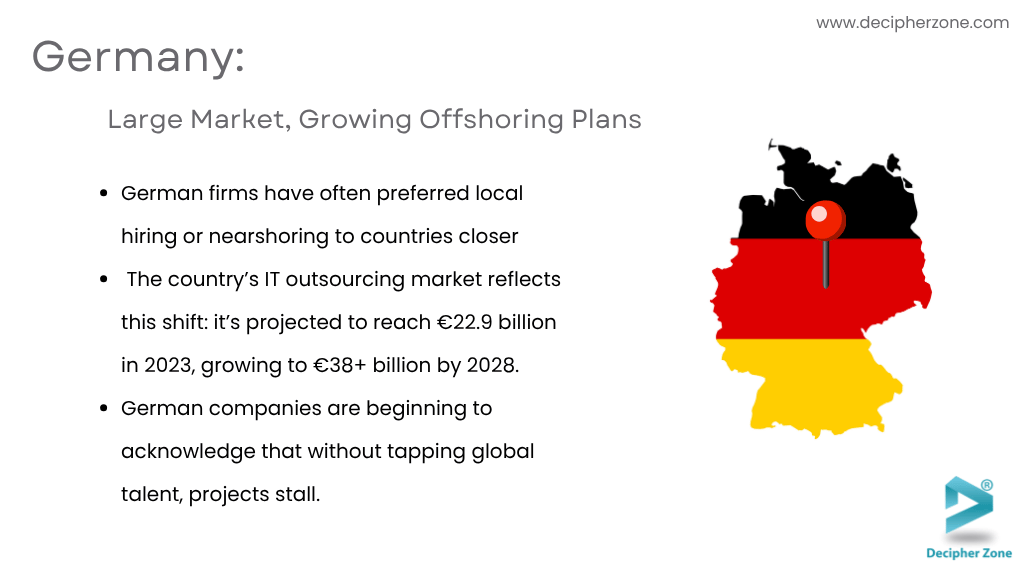
With Industrie 4.0 and digital transformation initiatives in full swing, German industries face an acute need for software talent that domestic supply alone cannot meet. The country’s IT outsourcing market reflects this shift: it’s projected to reach €22.9 billion in 2023, growing to €38+ billion by 2028. Critically, a recent survey of German IT executives found 72% plan to outsource at the same rate or more in coming years – a strong sign that attitudes are warming to remote teams.
One reason is necessity. Germany’s unemployment rate for IT professionals is extremely low; there simply aren’t enough React developers (or other specialists) available. The “War for Talent” is intense. Offshoring to India provides a much-needed talent valve. German companies are beginning to acknowledge that without tapping global talent, projects stall.
Language remains a consideration. Outside of internationally oriented startups, many German businesses conduct work in German. This has historically made Poland, Romania, or other Central/Eastern Europe (CEE) locations attractive due to closer time zones and sometimes German-speaking engineers. But even those nearshore markets are getting pricier and tighter on talent.
To leverage India, German firms often use a hybrid approach: engage an outsourcing partner that provides bilingual (German-English) liaisons or project managers. This way, the German client can communicate in German if needed, while the actual dev team operates in English behind the scenes. It’s a strategy that combines India’s strengths with a localized interface.
Notably, some German tech companies have made high-profile moves to India. For example, SAP (headquartered in Walldorf) employs thousands of developers in its Bangalore and Gurgaon offices. Siemens and Bosch have long-established R&D centers in India.
These precedents build confidence for others. And even mid-sized firms or startups are following suit by partnering with Indian development agencies or building dedicated offshore teams via intermediaries. The results have been positive: faster product cycles and cost reductions.
2. Netherlands: Tech Hub Embracing Global Teams
The Netherlands punches above its weight in tech. With the sixth-highest GDP in Europe and a thriving startup ecosystem, the Netherlands (especially Amsterdam’s “Silicon Canals”) has a huge appetite for developers. Interestingly, Dutch companies were early adopters of outsourcing and cloud services – their openness to international collaboration is part of the culture.
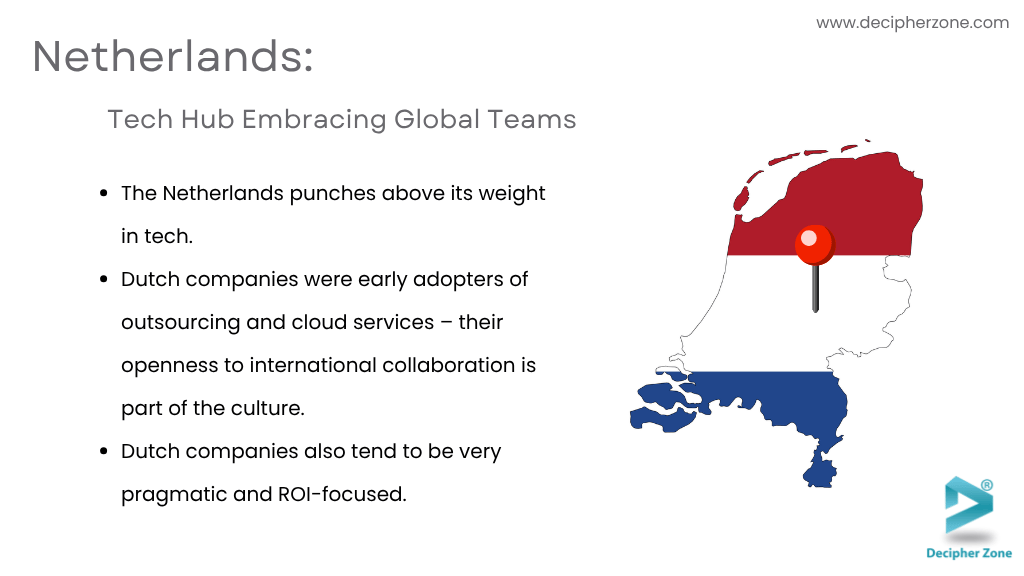
Today, the Netherlands stands out as the most enthusiastic outsourcing market in Europe: nearly 80% of Dutch CIOs say they will outsource at the same or higher rate in the coming years. This is the highest in Europe, signaling an environment very receptive to remote teams, including those in India.
Why such openness? Several factors converge. First, language is less of a barrier – the Dutch are among the most proficient English speakers in the world (aside from native countries). Working with an English-speaking Indian team is generally seamless for Dutch firms; there’s little need for translation or mediation.
Second, the Netherlands already has a history of offshoring parts of its IT – be it to India, Eastern Europe, or elsewhere – so processes and trust networks exist. Third, despite having a high density of tech workers internally, they still face shortages in cutting-edge skills.
In fact, the Netherlands’ own tech workforce is highly skilled yet insufficient to meet the booming demand for talent in areas like frontend development, AI, and fintech.
Dutch companies also tend to be very pragmatic and ROI-focused. They see the business case for remote Indian teams clearly: for example, why hire one expensive local developer when, for the same budget, you could hire two or three in India and get more done? Many SMEs and startups in Holland leverage Indian agencies to build their MVPs and later form dedicated offshore teams as they scale.
With over 600 international ICT companies operating in the Netherlands (180+ headquartered in Amsterdam alone), competition for local coders is fierce. Offshoring is a relief valve that allows Dutch firms to keep growing without being bottlenecked by talent. Even government projects in the Netherlands have occasionally tapped offshore IT services to meet deadlines, indicating broad acceptance.
Culturally, the Dutch are known for being direct and output-oriented, which meshes well with the outsourcing model that emphasizes deliverables and KPIs. Dutch firms also embraced remote work tools early; many were “remote-ready” before 2020.
This means they can integrate a team sitting in India almost as easily as if it were a team in another Dutch city. One interesting note: the Netherlands’ early adoption of cloud computing and remote collaboration tech has effectively smoothed the path for working with global teams.
3. United Kingdom: Cost-Focused and Outsourcing-Friendly
The UK has a long-standing relationship with outsourcing, especially with India. As a former colonial connection, India’s familiarity with British culture and the English language gave it a head start in serving UK companies’ IT needs since the 1990s.
Today, the UK remains Europe’s most open market to offshoring – by some measures, British firms are the least hesitant in the region to partner with providers in developing countries. Several reasons underpin this.
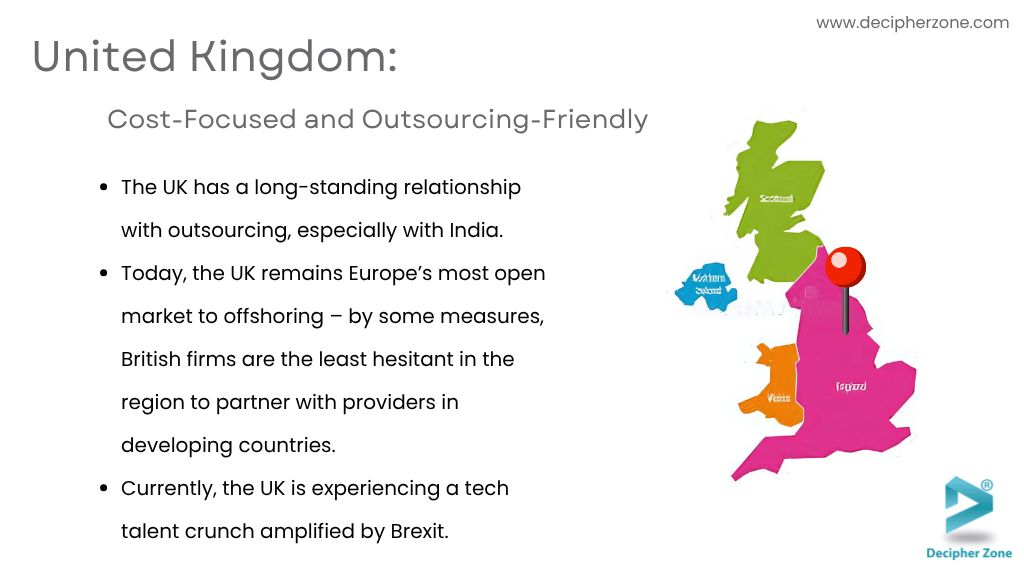
The UK’s business culture places a strong emphasis on cost efficiency and value for money, making the lower cost of Indian teams extremely attractive. Additionally, English being the shared language removes practically all communication barriers in UK-India collaborations.
Currently, the UK is experiencing a tech talent crunch amplified by Brexit. With many EU nationals who used to work in London’s tech scene having left or fewer coming in, local talent supply has tightened further.
Meanwhile, demand is climbing: the UK’s IT outsourcing market revenues are projected at €30+ billion in 2023, with ~9.5% annual growth expected. Surveys show 63% of British organizations intend to maintain or increase their outsourcing in the near future. Clearly, the UK sees offshoring as a key strategy to access skills and save costs.
In fact, some of the largest UK companies (and government projects) have long relied on Indian IT giants like TCS, Infosys, and Wipro to deliver crucial software and services.
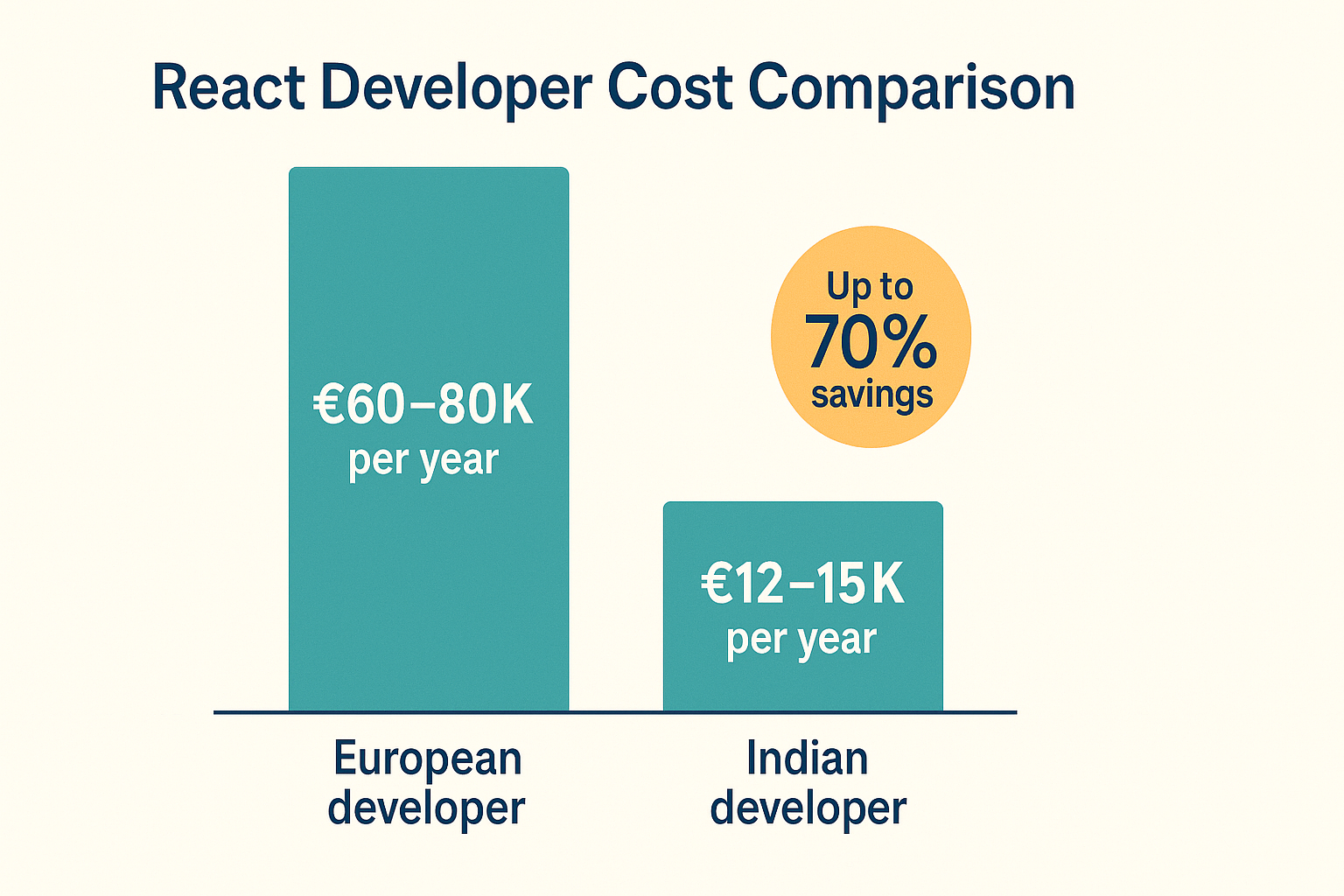
For React development, UK startups and scale-ups are quite comfortable hiring remotely. Many begin by contracting freelance developers or agencies in India for short-term needs and then expand to dedicated teams as they grow. They’re often pleasantly surprised by the quality and speed.
As one London-based founder quipped, “Our Indian React developers cost a third of my local ones and delivered twice as fast.” This may be anecdotal, but it underscores the perceived value. The historical ties also mean there’s a sizable Indian diaspora in the UK’s tech community, which can facilitate connections and trust. (Around 5% of the UK population has roots in South Asia, and many are in tech or entrepreneurial roles.)
Another aspect is that many UK firms have outsourcing baked into their operating model. It’s not seen as an emergency measure but as a standard option. British financial institutions, for example, routinely use Indian teams for development and support – often citing around-the-clock productivity and lower costs as big wins.
With the rise of remote work, even smaller companies can do this without setting up a foreign subsidiary; they just work with Indian talent virtually. And UK managers, being generally culturally aware and globally minded (London is a very international city), tend to navigate cross-cultural management with relative ease.
Read: React vs React Native
Challenges and How to Mitigate Them With Remote Indian Teams
Here are some common concerns European companies have – and proven ways to mitigate them:
-
Time Zone Coordination
-
Communication Gaps
-
Language and Cultural Differences
-
Quality Control
-
Data Security and IP Protection
-
Integration and Team Morale
Engaging a remote Indian React team comes with immense benefits, but it’s important to be aware of potential challenges and address them proactively.
1. Time Zone Coordination
There can be limited overlapping work hours between Europe and India. Mitigation: Schedule daily or bi-weekly overlap windows for live meetings (e.g., European morning which is afternoon in India).
Use asynchronous communication for everything else. Plan sprints such that tasks are well-defined, enabling independent progress. Some companies operate a “two-shift” system where urgent issues can be handed off across time zones, turning the difference into a productivity boost.
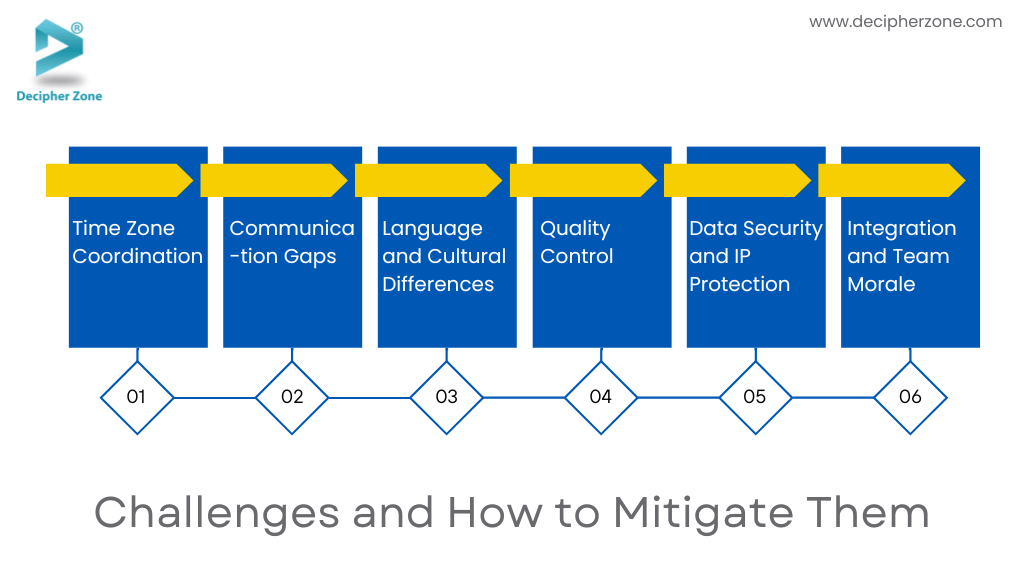
2. Communication Gaps
Misunderstandings can arise if requirements aren’t clear. Mitigation: Invest in clear documentation of feature requirements and technical designs. Encourage an open question culture – make it explicit that team members should ask for clarification anytime.
Using collaboration tools (like Jira for tasks, Slack/MS Teams for chat, and video calls for design discussions) keeps everyone on the same page. Also, establish a single point of contact on each side (e.g., a project manager or tech lead) to streamline information flow.
3. Language and Cultural Differences
While English is widely spoken, subtle differences in accent or communication style might exist. Culturally, Indian team members may initially hesitate to give bad news or disagree. Mitigation: Plan an onboarding phase to get teams comfortable with each other. Perhaps start with a small pilot project to establish rapport.
Encourage a culture of honesty and transparency; explicitly tell the team that raising concerns early is valued. Consider cultural training for both sides – even a basic session on Indian work culture for your European staff and vice-versa can build mutual understanding. Many firms also organize occasional in-person visits or team-building virtual events to strengthen personal connections.
4. Quality Control
There might be worries about code quality or adherence to standards when work is done remotely.
Mitigation: Treat the remote team as an integral part of your engineering org. Implement the same code review processes, CI/CD pipeline, and quality gates (linting, tests, etc.) as you would for local developers.
Use agile methodologies – sprint planning, reviews, retrospectives – with full participation from the Indian team to ensure accountability and continuous improvement. If working through an outsourcing provider, ensure they allow you to interview and approve each team member, so you’re confident in their skill level. Starting with a trial period for new developers can also help evaluate fit and quality before fully committing.
5. Data Security and IP Protection
Handing over code access and sensitive project knowledge to an overseas team requires trust.
Mitigation: Work with reputable partners who have strong security protocols (ISO certifications, adherence to GDPR for EU projects, etc.).
Sign clear contracts that include Non-Disclosure Agreements (NDAs) and clauses that all intellectual property created is owned by your company. Most Indian firms are used to these requirements. You can also implement technical measures: grant access to only necessary systems, use VPNs or secure development environments, and conduct security audits if needed.
With the right agreements and oversight, companies like those in finance and healthcare successfully work with Indian teams while protecting customer data and IP.
6. Integration and Team Morale
Remote teams might feel isolated or “out of sight, out of mind.”
Mitigation: Make inclusion a priority. Have the Indian developers join all relevant calls (daily stand-ups, planning meetings, etc.) rather than treating them as an external adjunct. Celebrate wins together – if the team in India hits a milestone, acknowledge them in your company’s internal comms.
Some companies fly key team members to Europe for quarterly meetups or invite them to company offsite events (and likewise, European leads visit India occasionally).
Build Your Remote React Team in India—Get Started With a Free Consultation
Even if budget doesn’t allow travel, simple gestures like company swag, virtual coffee breaks, or shouting out birthdays/holidays can make a remote team feel truly part of the family. An engaged team is a productive team, no matter the distance.
Actionable Takeaways to Prefer Remote Indian Teams
For busy founders and tech leaders, here are the key points and action steps distilled:
-
European Tech Talent is Hard to Find
-
Remote Indian Teams Offer a Solution
-
Quality and Expertise Can Be World-Class
-
Faster Hiring, Flexible Scaling
-
Effective Collaboration is Achievable
-
Embrace the Cultural Mix
-
Secure Your IP and Data
1. European Tech Talent is Hard to Find
The developer shortage in Europe (over 500k unfilled roles) is real – if you’re struggling to hire React developers locally, you’re not alone.
Action: Don’t let projects stall; consider global talent options early.
2. Remote Indian Teams Offer a Solution
India provides top-notch React developers at a fraction of European costs, thanks to a vast talent pool and lower salary levels. Many European companies save 50% or more on development costs this way.
Action: Calculate the potential cost savings for your project if you outsourced some development – the numbers might surprise you.
.avif)
3. Quality and Expertise Can Be World-Class
Indian engineers are building software for Google, Amazon, and global startups alike. With proper vetting, you can get highly skilled, experienced React developers who write clean, robust code.
Action: Partner with reputable firms or use thorough interview processes to handpick developers. Don’t compromise on quality – you don’t have to, given the talent available.
4. Faster Hiring, Flexible Scaling
Need to hire a team yesterday? India’s huge talent pipeline means positions can often be filled weeks faster than in Europe. You can also scale your team up or down more flexibly.
Action: Use this to your advantage – plan for an initial pilot team, and have a roadmap for scaling if the pilot goes well. Communicate those growth opportunities to your partner so they can keep an eye out for additional talent.
5. Effective Collaboration is Achievable
Time zones and distance are manageable with today’s tools and a remote-friendly mindset.
Action: Set up a clear communication cadence (daily stand-ups, weekly demos, etc.). Ensure at least a couple of overlapping hours for real-time sync, and leverage async updates (like Slack or recorded loom videos) for the rest. Investing in a bit of process goes a long way.

6. Embrace the Cultural Mix
European and Indian teams working together can bring diverse ideas to the table. Indian developers are often very motivated and eager to impress – use that positive energy.
Action: Integrate the team fully. Share your company’s vision, include them in brainstorming, and recognize their contributions. A team that feels valued will go the extra mile for your success.
7. Secure Your IP and Data
Don’t let security worries hold you back. The legal frameworks and best practices exist to work securely with overseas teams.
Action: Have solid contracts and NDAs in place. Limit access permissions smartly and use trusted IT service providers. It’s standard procedure for most, and you can seek legal counsel to ensure you’re covered.
Conclusion
European companies are learning that when it comes to building software teams, the world is truly flat. With a pressing need for React developers and other software talent, looking locally is no longer enough.
Remote Indian teams have emerged as a preferred solution, marrying cost-effectiveness, skill abundance, and reliable quality. Germany is easing into offshoring to stay competitive, Dutch firms are practically leading the charge in outsourcing, and UK businesses have made it a core part of their strategy.
Across Europe, the message is clear: tapping into India’s tech talent is not just about outsourcing to cut costs – it’s about gaining a strategic edge in delivering projects faster and better.
Read: Enhance Your Web Application with a ReactJS Development Company
If you’re a European founder, HR manager, or CTO, the implications are exciting. By embracing a remote Indian React development team, you can supercharge your development capacity without breaking the bank.
Imagine being able to accelerate your product roadmap, finally fill those open developer roles, and extend your team’s working hours to achieve round-the-clock progress. All of this is possible by leveraging the platform that globalization and remote work technology have laid out for us.
Ready to leverage top React talent in India for your next project? Start by identifying a role or project that could be executed remotely. Reach out to a trusted development partner or platform that specializes in connecting European companies with Indian developers.
Have a conversation about your needs and see the candidates or team structure they propose. You can even begin with a small pilot project to evaluate the experience. You’ll likely find that any initial concerns about distance or coordination fade away once the work is underway and quality deliverables come in.
Don't Wait Months for Developers—Discover India's React Experts Now
Don’t let the tech talent shortage slow you down. By building your remote React team in India, you can keep innovating and scaling – with the confidence that you have a capable, dedicated team supporting your vision from 7,000 kilometers away. It’s a step that countless European companies have taken to great success. Your next breakthrough might just be one global team-up away.
Take that step, and supercharge your development with the best of Indian talent – your business will thank you for it.
FAQ
Why do European companies prefer Indian teams for React development?
European companies often prefer Indian teams for React development because outsourcing to India offers cost-effective solutions and access to a large pool of skilled developers. Indian React developers are usually well-trained, proficient in English and modern tools. Competitive rates combined with high technical expertise make remote Indian teams attractive options.
How do we manage communication with a remote Indian development team?
Communication with a remote Indian development team relies on clear processes and tools. Use channels like Slack, Teams or email for daily updates. Schedule regular video calls (during overlapping hours) and agile stand-ups. Document requirements and encourage open English discussions. Indian teams often have strong English skills, reducing language barriers and keeping everyone aligned.
What about time zone differences when working with Indian developers?
Time zone differences can be managed with planning. India is 3.5–5.5 hours ahead of most European countries, so schedule meetings during the overlap (morning in Europe, afternoon in India). Use flexible hours and clear handoff notes for uninterrupted progress. With good coordination, time zones can even enable 24/7 productivity.
How much cost savings can we expect by hiring React developers in India?
Outsourcing to India can yield substantial savings. Indian React developers often charge 50–70% less per hour than their Western European counterparts, thanks to lower living costs. For example, a senior React dev might cost around $30–$50/hr in India vs $80–$130/hr in Europe. These lower rates allow significant budget flexibility.
Are Indian React developers as skilled as developers in Europe?
Yes. India produces a large number of qualified React developers. Many have computer science degrees and global work experience, and they often speak fluent English. When hired through reputable vendors or agencies, their technical skills and knowledge of modern tools typically match European standards. Quality can vary, so vet candidates and portfolios.
How is intellectual property and data security handled when outsourcing to India?
Outsourcing contracts with Indian teams include strict NDAs and IP clauses to protect your ideas. Many Indian IT firms follow global security standards (ISO 27001) and data protection rules (GDPR) and use secure tools. India’s legal system also recognizes foreign IP rights. Clear contracts and compliance ensure your intellectual property and data stay secure.
**Disclaimer: Some images used in this article have been generated with the assistance of AI.

